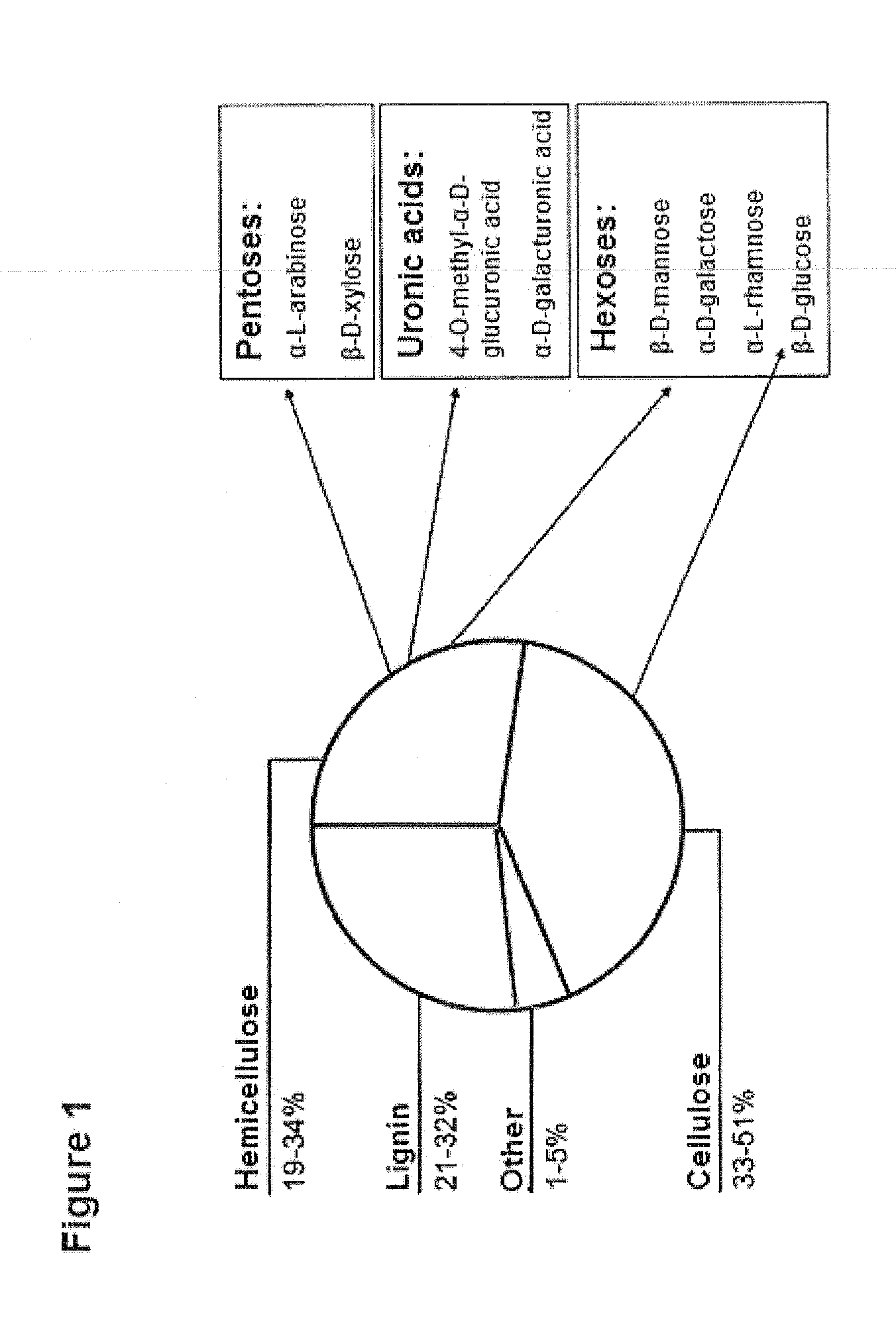Prokaryotic Xylose Isomerase for the Construction of Xylose Fermenting Yeasts
a technology of xylose fermentation yeast and isomerase, which is applied in the direction of isomerase, enzymes, biochemical apparatus and processes, etc., can solve the problems of xylose fermentation disruption, large quantity, and imbalance in redox balan
- Summary
- Abstract
- Description
- Claims
- Application Information
AI Technical Summary
Problems solved by technology
Method used
Image
Examples
example 1
Screen of a (Highly) Functional Prokaryotic Xylose Isomerase
[0214]A) Construction of MKY09
[0215]In the yeast strain CEN.PK2-1C, all the genes of the non-oxidative pentose phosphate pathway as well as the xylulokinase (XKS1) and GAL2 were overexpressed. To this end, the endogenous promoters were replaced with the truncated HXT7 promoter. This strain was named MKY09 and used for the screen for functional xylose isomerases.
[0216]B) Selection of the Xylose Isomerases to be Tested
[0217]To make a selection of the xylose isomerases to be tested, protein sequences of xylose isomerases from the database NCBI BLAST were compared. An excerpt of the xylose isomerase obtained is depicted in FIG. 3. 14 xylose isomerases from different organisms were selected to be tested on their functionality in yeast.
[0218]C) Execution of the Screen
[0219]To this end, genomic DNA was isolated from the organisms. The cells were grown, harvested and disrupted (see “Isolation of plasmid DNA from S. cerevisiae” and ...
example 2
Codon Optimization of the Gene for Xylose Degradation in Yeast Codon Optimization of Genes According to the Codon Usage of the Glycolysis Genes from S. cerevisiae
[0222]The preferred codon usage of the glycolysis genes from S. cerevisiae was determined and is listed in table 1. The ORF of the gene XI from C. phytofermentans was codon-optimized. That is, the sequences of the open reading frame were adapted to the preferred codon usage indicated below. The protein sequence of the enzymes remained unchanged. The genes were synthesized by an external company and supplied in dried form in company-owned vectors. Further details about the synthesis of genes can be found under www.geneart.com.
TABLE 1Preferred codon usage of the glycolytic genes from S. cerevisiaeCodon usage ofAmino acidcodon-optimized genesAlaGCTArgAGAAsnAACAspGACCysTGTGlnCAAGluGAAGlyGGTHisCACMeATTLeuTTGLysAAGMetATGPheTTCProCCASerTCTThrACCTrpTGGTyrTACValGTTStopTAA
[0223]B) Introduction of the Codon-Optimized Xylose Isomerase...
example 3
Characterization of the Functional Prokaryotic Xylose Isomerase
[0225]A) Growth Behaviour and Xylose Conversion
[0226]The growth of the strain MKY09 with the native and the codon-optimized xylose isomerase from C. phytofermentans was investigated in growth tests on medium containing xylose under aerobic conditions. The empty vector p426HXT7-6HIS served as a comparison.
[0227]The strains were grown in SC medium with 0.1% glucose and 1.4% xylose and inoculated with an OD600 nm=0.2 in 50 ml of SC medium with 0.1% glucose and 1.4% xylose. The incubation was performed in shaking flasks under aerobic conditions at 30° C. Samples for the determination of the optical density and for the determination of the metabolite composition were taken several times.
[0228]The growth curves showed that all the recombinant yeasts grew on glucose up to an OD600 of 2.5 (table 2). After another 50 h, the yeast strain containing the native xylose isomerase from C. phytofermentans began to grow further on xylose...
PUM
| Property | Measurement | Unit |
|---|---|---|
| dry weight | aaaaa | aaaaa |
| temperature | aaaaa | aaaaa |
| temperature | aaaaa | aaaaa |
Abstract
Description
Claims
Application Information
 Login to View More
Login to View More - R&D
- Intellectual Property
- Life Sciences
- Materials
- Tech Scout
- Unparalleled Data Quality
- Higher Quality Content
- 60% Fewer Hallucinations
Browse by: Latest US Patents, China's latest patents, Technical Efficacy Thesaurus, Application Domain, Technology Topic, Popular Technical Reports.
© 2025 PatSnap. All rights reserved.Legal|Privacy policy|Modern Slavery Act Transparency Statement|Sitemap|About US| Contact US: help@patsnap.com



